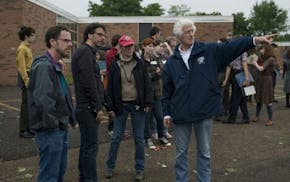In Paula Hawkins' powerful thriller, "The Girl on the Train," you must wait for something awful to happen, and it's worth it.
There is no predictable dead body discovered at the end of the first chapter, as in half the mysteries you've ever read.
The main character, Rachel Watson, is so pathetically unlikable that there's a danger you'll slap the book down in distaste, and give up on the story.
That would be a big mistake.
Hawkins' tale of love, regret, violence and forgetting is an engrossing psychological thriller with plenty of surprises.
It is Hawkins' first major book after three previous novels, written under a pseudonym. It will remind you of Alfred Hitchcock's best work, especially "Rear Window," his 1954 movie about an injured photographer who spends his days looking into his neighbors' apartments.
Rachel is the girl on the train, a voyeuristic passenger on a daily, one-hour commute into London from its western suburbs. Along the way, the train often stops for several minutes near Rachel's old house, where she lived briefly and happily with her then-husband. From her train window, she gazes into the back yards, porches and windows of her former neighborhood.
From the train window, she glimpses the lives of middle-class families, a daily reminder of her own perceived failings: She's in her 30s, divorced, childless, lonely and possibly an alcoholic. She has not a soul she is close to. Like the train, she is going through the motions.
Her self-destructive life revolves around resentment and jealousy, especially of her ex-husband's new life. She suffers from drunken blackouts and outbursts that leave her confused and feeling guilty, though she's not sure of what.
Then something bad happens, and her loss of control takes a chilling turn.
The book, set in 2012 and 2013, cleverly jumps back and forth in time to first reveal the mystery, and then to eventually unravel it. The story gets much of its power from alternating first-person narratives, not unlike Gillian Flynn's bestselling thriller, "Gone Girl." In "The Girl on the Train," three female characters recount the events of their lives, which intersect in creepy ways.
The novel gets harder and harder to put down as the story screeches toward its unexpected ending.
David Shaffer is a Star Tribune reporter.

Meet the Oscar-winning cinematographer who has changed the way the movies look
An Algerian reporter says he was expelled from his country without explanation

A former deli maestro steps into Capt. von Trapp's shoes in Artistry's 'Sound of Music'

NPG vets Michael Bland and Sonny Thompson extend their brotherhood into a post-Prince duo

